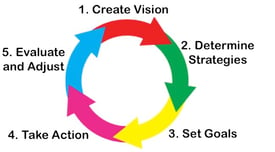Today we’re sharing insight from guest blogger Jesse Lyn Stoner, business consultant, coach, former executive, and bestselling author. We hope you enjoy Jesse's wisdom and perspective.
One of the biggest mistakes leaders make is moving from vision to execution as though it’s a linear process. The widely held assumption is they are two ends of a spectrum: Vision is about planning. Execution is about action.
The truth is: Vision requires action to be clarified and refined, and execution requires reflection to be effective.
It’s Not Linear
Most leadership experts subscribe to some variation of these five steps.

The model is logical. But in reality, most of us don’t live our lives that way, and most leaders are not rigorous about it, because life doesn’t wait while you are planning. No wonder so many leaders have little patience with the first steps.
Circular Is Better
 When you think of these steps as circular, it gives a better sense of their ongoing repeating nature.
When you think of these steps as circular, it gives a better sense of their ongoing repeating nature.
A reality check will verify that all of these steps are important. Anyone who has worked with a leader who acts randomly (“ready-fire-aim”) knows what a mess they leave behind. And leaders who avoid taking action can be just as frustrating.
But this approach is still sequential and doesn’t match up with the reality of our messy lives and organizations. It’s simply not accurate to represent a dynamic, interrelated process as a series of sequential steps.
Try Spinning The Circles
 Try thinking of the circle as dynamic – spinning so fast that the colors turn white. You can’t see the individual parts, even though you know they’re there.
Try thinking of the circle as dynamic – spinning so fast that the colors turn white. You can’t see the individual parts, even though you know they’re there.
While working on one step, you pay attention to how that step impacts all the other steps. Which steps you need to focus on at any point are determined by feedback from your environment and your own experience, instead of a chart.
This is a way of working and doing business, not simply a way to approach projects. And since it is ongoing, “evaluate and adjust” is no longer a step. It becomes integrated into daily life and the way you approach work.
By acknowledging reality is far from linear and assuming a dynamic approach, you are freed to work on the right steps at the right time. And both your vision and execution will become smarter, easier, faster, and smoother.
3 Guidelines For A Dynamic Approach
Do vision and execution simultaneously.
Don’t separate vision and execution as though they are two different things. As you develop your vision, no matter what stage your vision is in, continually align your actions with it. And don’t set your vision aside once you’ve moved to another step.
You don’t have to wait for your vision to be “finished” before you start. Build it as you envision it. Learn and adjust as you go.
Think of your vision as unbaked clay.
Allow your vision to be reshaped based on new information, feedback, what you have learned and changes in your environment. Don’t assume that you “own” the vision. Allow others to influence its shape – to put their thumbprints on it.
As you move closer to your vision, you will understand it more deeply. It might look like it has changed on the outside, but the essence will remain the same.
Be fluid.
When working on any of these steps, give it your full attention and strive for excellence, but always consider the big picture and how what you are doing affects the other steps. Be ready to move fluidly among the steps as it makes sense.
Although these are described as distinct steps, in reality they are not separate. This is simply a model to help you organize your thinking, and it not reality.
This content was written and shared by guest blogger Jesse Lyn Stoner. Click here to see the original post. © 2015 Jesse Stoner
In keeping with our ‘What’s The Risk’ format, CEO Tim Leman shares his thoughts on Jesse’s blog:
What’s The Risk?
If leaders can’t approach the vision and execution process dynamically, and don’t move fluidly through the various steps, they risk the over complication of a necessary mechanism. The mess created by doing it wrong can be disastrous to any organization. Embrace the steps needed and watch the incredible transformation.
 Jesse Lyn Stoner is a former business exec, consultant, and author of several books including the international bestseller Full Steam Ahead! Unleash the Power of Vision, co-authored with Ken Blanchard. Over the past 25 years Jesse has worked with hundreds of leaders using collaborative processes to engage the entire workforce in creating their desired future. Her clients range from Fortune 500's to non-profits worldwide, including Honda, Marriott, Edelman Public Relations, Skanska, SAP and YPO to name a few. She writes an award winning leadership blog and is published and quoted in the Harvard Business Review, Forbes, and numerous other journals and magazines.
Jesse Lyn Stoner is a former business exec, consultant, and author of several books including the international bestseller Full Steam Ahead! Unleash the Power of Vision, co-authored with Ken Blanchard. Over the past 25 years Jesse has worked with hundreds of leaders using collaborative processes to engage the entire workforce in creating their desired future. Her clients range from Fortune 500's to non-profits worldwide, including Honda, Marriott, Edelman Public Relations, Skanska, SAP and YPO to name a few. She writes an award winning leadership blog and is published and quoted in the Harvard Business Review, Forbes, and numerous other journals and magazines.
Connect with Jesse on LinkedIn and Twitter. Read more by Jesse on her blog.



